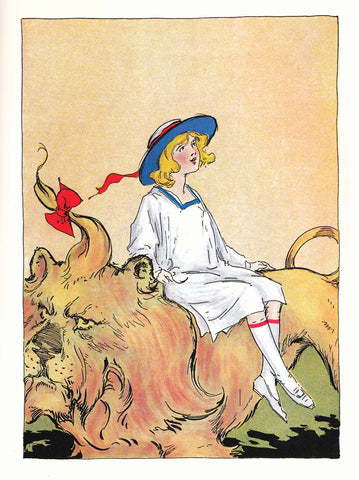 VISIT
MUSEUM STORE
MEMBERSHIP
OZ NEWS
CONTACT
VISIT
MUSEUM STORE
MEMBERSHIP
OZ NEWS
CONTACT
Discovering OZ: The Royal Histories - Tin Woodman
TWIN TIN WOODMEN, THE RAINBOW’S DAUGHTER, A WANDERING WOOT, UNBREAKABLE TRANSFORMATIONS ... AND THE SCARECROW, TOO!
by John Fricke

[Above: L. Frank Baum’s THE TIN WOODMAN OF OZ was originally published in 1918 -- another major success in the Oz Book Series, as built around (and titled after) one of the “Famous Four” travelers from Baum’s original THE WONDERFUL WIZARD OF OZ. Twenty-one years later, the popular Metro-Goldwyn-Mayer movie of the latter story inspired the Oz Book publishers to briefly issue less expensive, “Popular Editions” of several of the series, with redrawn cover art in the fashion of John R. Neill, the actual illustrator of the book itself. The picture here shows how the ever-popular TIN WOODMAN went briefly to market in that new format in 1940.]
NOTE: John R. Neill’s name is familiar to any who have read these Oz Book Blogs. Except for the first of Baum’s titles, he pictured every other Oz series volume published between 1904 and 1942. By the early 1950s, however, publishers Reilly & Lee decided it was time to modernize the appearance of the ever-popular Oz titles, and they hired Dale Ulrey to launch their experiment by providing pictures for a “new look” edition of THE TIN WOODMAN OF OZ (1955). Ulrey was a respected graphic artist, perhaps best known for drawing such popular, long-running comic strips as those about MARY WORTH. Her Oz art proved to be lovely (Reilly & Lee next assigned her the job of re-illustrating THE WIZARD OF OZ in 1956), but the fresh appearance of THE TIN WOODMAN OF OZ was disconcerting to – and ultimately unpopular with -- Oz readers, understandably loyal to Neill. So the concept of rejuvenating Oz illustrations was abandoned, but now – all these decades later -- Dale Ulrey’s attractive pictures warrant re-exposure. Thus, this Blog features some of her TIN WOODMAN pictures, as well as some for that book by Neill. Lest there be any confusion, they’re differentiated by name or by a [U] or an [N] in the descriptions below! 😊 ]
After returning to the Oz Book Series in 1913, L. Frank Baum continued to deliver a full-length fantasy about that country and its characters to publishers Reilly & Britton (it became Reilly and Lee in 1919) on an annual basis. The famous and favorite citizens -- always augmented by new ones – turned up in both familiar and innovative locales; the Land of Oz and its populace seemed ever able to expand! Baum’s plots throughout the series remained in mostly comfortable templates, ranging from searches (for the lost princess; for the Shaggy Man’s brother; for the antidote to the Liquid of Petrification) to rescues (Trot, Cap’n Bill, and Button Bright from Jinxland; the Queen of Ev and her children from the Nome King) to travelogues – the latter generally experienced while protagonists were en route to the Emerald City. On occasion, the playful Baum even mixed and matched such formats.
For his twelfth title, published in 1918, the author chose to throw the spotlight on THE TIN WOODMAN OF OZ -- a primary character who (though always around) had become somewhat tangential to any principal action after the three earliest Oz stories. The inspiration for Baum’s plot may well have been fan-flamed; in his opening letter “to my readers,” he explained that “many of you have asked me, time and again, whatever became of the ‘pretty Munchkin girl’ whom Nick Chopper” – i.e., the Tin Woodman -- “was engaged to marry before the Wicked Witch enchanted his axe, and he traded flesh for tin.” Yet whether drawn from the questions of rabid aficionados or magnified by his own inherent genius, Baum found in that topic the perfect means of launching a worthy narrative.
THE TIN WOODMAN OF OZ begins when a young Gillikin boy – the game-for-anything Woot the Wanderer -- approaches Nick Chopper’s tin castle and is welcomed by the Emperor and the latter’s boon companion, the Scarecrow. At his own request, Woot hears about the Tin Woodman’s personal background: how a once flesh-and-blood Munchkin man had evolved into a majestic tin creation. Such a tale, however, then inspires Woot himself to echo the purported query of Oz book readers: What are the present-day whereabouts of the loyal young lady who’d loved the man of both meat and metal? By end of chapter two, the lad, Tin Woodman, and Scarecrow have decided to go off to find her – Nimmee Amee by name -- and the magic unfurls from there. (Below [U]: Woot enjoys the company of two friends new to him but rapturously familiar to all of us.)

The saga is pure Baum, including a couple of major plot twists along the way and an even bigger one at the finale. The first half of THE TIN WOODMAN OF OZ details the complications that arise when the trio is entrapped in the castle of the giantess, Mrs. Yoop. A mammoth woman, she is initially semi-gracious, but as she’s already captured Polychrome the Rainbow’s Daughter and turned her into a canary, Mrs. Yoop immediately plans similar transformations for the Woodman (who becomes a tin owl), the Scarecrow (who becomes a straw-stuffed bear), and the boy (who becomes a pea-green monkey). Frighteningly – and as a Yookoohoo magic worker -- Mrs. Yoop chillingly and proudly warns them, “Nothing I transform ever gets back to its former shape again.” (The italics are present in the Baum book, and I can vouch for the emotional emphasis they wrought in me as a fledgling seven-year-old reader, who already considered the Tin Woodman and Scarecrow lifelong-companions-to-be.) Mrs. Yoop is shown here [U] as she contemplates our friends, prior to assigning their new identities:

The damage is soon done, but thanks to Polychrome’s wisdom and powers of observation, all four of them manage an escape from Mrs. Yoop. It eventually, however, requires the intervention of Ozma of Oz herself -- and more of Polly’s magical thought-processing -- to rid our quartet of their unhappy new shapes. (Even Ozma initially despairs of reversing Woot’s makeover, but the manner in which he again becomes a boy -- and the subsequent fate of the evil Mrs. Yoop -- is a stirring moment of Oz sorcery.) Below (top:) In their new guises, our unhappy travelers are dispersed by an old comrade, “General” Jinjur, who doesn’t at first recognize them when they seek shelter in her house [U]; (center:) Ozma, Dorothy, and Toto – definitively augmented by the Sawhorse – soar to Jinjur’s home in hopes of breaking Mrs. Yoop’s unbreakable alterations [U]; (bottom:) The Rightful Ruler of Oz at work, attempting the magic that might restore Woot’s proper form [N].



In the book’s second half, the Tin Woodman, Scarecrow, Woot, and Polychrome renew the search for Nimmee Amee. Much to their astonishment, they unexpectedly come across another man made of tin – this one with the cap and sword of a soldier. It turns out that he had been a military, flesh-and-blood later suitor for the Munchkin maiden, and the same Wicked Witch enchanted his weapon to keep him from courting her. As such, he gradually became all tin via the exemplary workmanship of Ku-Klip, the same tinsmith who’d earlier reconstituted Nick Chopper. Much like Nick, however, the Tin Soldier had also rusted before he could marry the girl, and he stood immobilized in the forest until our foursome came along and oiled him. The amiable Captain Fyter then joined their company to search for the girl, and he and Nick affably agreed to let Nimmee choose between them [N]:

On either side of these primary excursions and narrative points, Baum intertwines the customary Ozian side jaunts and confrontations. There are the softly combative balloon people of Loonville [U]:

There’s a hungry jaguar who would eat Woot except for Polly’s ability to magically offer a substitute in scrambled eggs on toast – plus a den of dragonettes, who rival the leopard’s categorization of the boy as a likely meal [U]:

The wanderers also meet a professorial pig and his wife, whose nine tiny piglets have already left home to become celebrated companions of the Wizard of Oz himself [U]:

There’s an enchanted messenger boy, Tommy Kwikstep, whose mindless and unintentional wish has endowed him with eighteen additional legs [N]:

In an Invisible Country, our five compatriots escape – but then fortunately reencounter -- a reasonably jolly (if also hungry) Hip-po-gy-raf, to whom the Scarecrow gracious sacrifices his straw stuffing in exchange for the beast’s cooperation in conveying the travelers across an impassable gulf [N]:

And there’s a nostalgic and genuinely joyous reunion with Ku-Klip himself. The merry tinsmith provides the quintet with counseling about the present-day location of Nimmee Amie [N]:

It’s worth noting, too, that one of the most imaginative episodes of THE TIN WOODMAN OF OZ – always intriguing-to-children and perhaps ever-more-mind-boggling to present-day analytical adults – occurs when the Woodman opens a cupboard in Ku-Klip’s workshop and discovers his living former head. (Remember: No one in Oz ever dies.) Their conversation is perfunctory, as Nick Chopper’s original pate has no knowledge of the tin version of himself and manifests less than no desire to become acquainted with his subsequent metallic counterpart. (Baum titled one of the book’s chapters after this get-together, and Neill provided a picture true to the situation:)

The third peak of Baum’s journalistic flair comes at the finale, when Nimmee Amee is traced to a remote location in the Munchkin Country. Not unnaturally, the young woman is somewhat bemused to be simultaneously confronted by two former suitors of many years past, and the author’s introduction of a final new character named Chopfyt caps the tale as satisfactorily and bizarrely as anything could! That being said, Neill contributes his own capture of the historical moment when the Tin Soldier – for personal reasons of his own -- rather defiantly (though briefly) faced off with Chopfyt:)

THE TIN WOODMAN OF OZ made its debut in stores in autumn 1918, just before the United States was able to celebrate its victory in World War I. Sales of the new Oz title were commensurately joyous, and perhaps the Pittsburgh SUN of September 23, 1918, best summaries both the popular and critical reaction to the latest Baum/Neill achievement:
“If I could have a wish granted, I would turn crier and go up and down throughout the country before Christmas, ringing the bell and calling in a loud voice to all the young of heart – be they 6 or 60, who have never read an Oz book – to follow me to a quiet spot, and there treat myself to a good time. Beginning with THE LAND OF OZ, I would read them aloud, and I am afraid I would hurry a little until I reached THE TIN WOODMAN OF OZ. For I have just finished this delightful book of adventure and would like to return to the interesting group Mr. Baum has introduced me to in it . . .. It is a thrilling tale of hairbreadth escapes and all kinds of troubles with queer animals and people . . .. Of course, there are nice persons, also . . . a host of others just as fascinating. The book Is well-illustrated and makes an ideal Christmas gift.”

What else need be said? 😊
Thank you for reading!
-------------------------------------------
[One more NOTE, please! If you’ll go to Wamego’s OZ Museum Facebook page and scroll down to the entry for January 23rd, you’ll see and hear the ninety-second vlog about THE TIN WOODMAN OF OZ. It shows the original John R. Neill book cover, as well as more of his art from the pages of that volume – and I happily recommend the visual joys and fun of continuing to compare what “Jno” did in 1918 (on display there) with some of what Dale Ulrey did in 1957, as shown above!]Article by John Fricke


